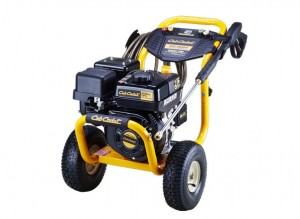A pressure washer is a great tool for cleaning everything from boats to patios, but in inexperienced hands, this piece equipment can be dangerous and destructive. Here’s what you need to know to operate your Cub Cadet pressure washer without endangering yourself or your belongings.
More Powerful than You Think
Cub Cadet’s pressure washers are rated between 3,000 and 4,000 psi. What does that mean in layman terms? The average garden hose hooked up to a residential water supply delivers water at a pressure of around 50 psi, so by the time that water leaves the spray nozzle, it has 600-800 times the force behind it. That’s also about 6 times the pressure of the most powerful fire hose nozzles.
Setting Up Your Pressure Washer
The engine is not shipped with oil in the crankcase. This needs to be added before you first start the pressure washer, or the engine can be damaged.
Since you’ll probably use your washer intermittently, it’s a good idea to use fuel treated with a stabilizer. Stabilized fuel can be used for up to three months from its purchase date, but after that, the tank should be drained.
Basic Safety and Use
Keep your pressure washer dry. Spraying the engine can force water inside which will mix with the oil. The resulting sticky emulsion won’t coat internal components, leading to accelerated wear and damage. If water gets in the intake, it can lead to a sharp increase in combustion chamber pressures, causing major damage to the piston, head and connecting rod.
Keep the hose away from the engine. Parts of the motor, and the exhaust, in particular, can get hot enough to melt the hose’s outer coating.
Be sure to check the screen on the inlet before hooking up the hose. If it’s missing, debris can enter the pump, damaging it.
If there’s a leak in the wand, handle or high-pressure hose, stop the engine immediately. These parts need to be replaced before the washer is used again.
When operating your pressure washer, you should always wear safety glasses, rubber gloves clothing non-slip shoes.
Skin Contact Is Serious
Fluid injection is not the same as a cut. Water forced into your body can lead to infections and blood poisoning, turning what seems like a minor injury into a major medical problem that can require hospital stays, months of physical therapy and possibly amputation. If you spray yourself and it splits the skin, go to a doctor immediately. Your chances of a good outcome increase dramatically if the wound is debrided within 6 hours of the injury.
Preparing the Area
Keep people and pets well away from the work area. Remove or secure any lightweight objects. If struck by the spray, they can turn into projectiles.
If possible, work in an area far away from any electrical wiring. Where that’s not feasible, be sure to cover any nearby electrical outlets to prevents shorts from overspray.
Soaps and Detergents
Only use cleaning chemicals designed specifically for pressure washers. Other off-the-shelf soaps and cleaners may damage the pump. Never use any solution that contains bleach: runoff is poisonous to plants and can cause skin damage on contact.
Read the instructions: some chemicals are ready to be used straight out of the bottle, while others need to be diluted. The wand will only dispense detergent if it’s being used with the black nozzle.
Starting the Engine Safely
Before starting, turn on the water at the faucet, then hold down the trigger on the gun. This will purge air inside the system, taking stress off of the pump when the engine is started. If the engine doesn’t start after a couple pulls, hold down the trigger on the gun to release any pressure inside the pump. This will make the engine easier to turn over and will prevent kickback.
Using the Wand
If you need to set down the wand for any reason, lock the safety on the trigger. When using, always hold the gun with two hands so you can compensate for the initial kickback.
Choosing a Nozzle
A smaller spray angle means more power, which means better, faster cleaning, right? If you reach for the narrow red nozzle first, there’s a good chance you’ll end up damaging whatever you’re cleaning. For painted surfaces, stick to the white tip. For other surfaces, use the green tip. The yellow and red tips are only for cleaning thick buildup off of sturdy, wear-resistance surfaces.
Keep Your Pressure Washer in Top Condition
Cubparts.com is a certified dealer for Cub Cadet and their manufacturing partners, making us your one-stop shop for everything on your pressure washer. Our site can show you exploded parts diagrams straight from the manufacturer so you can match up what you’re ordering with the part on your machine. We ship across the USA and Canada.

